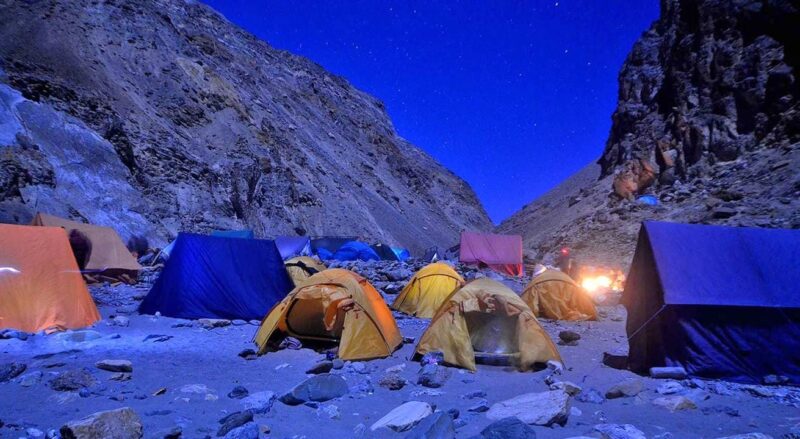Introduction
Renowned globally as one of the most surreal and challenging winter treks, the Chadar Trek expedition entails a breathtaking hike across the frozen Zanskar river in the starkly breathtaking region of Ladakh. The prime months of January-February see the mercury plunge as low as -35 degree Celsius here with icy winds blowing intensely across the cold desert.
Embarking on the frozen river trek hence demands diligent health, gear and safety preparedness along with loads of mental tenacity to complete this test of endurance. Here are 5 of the most vital aspects to bear in mind when prepping for your epic Chadar adventure:
Allow Ample Time for Proper Acclimatization
The Chadar trek requires walking at intimidating altitudes ranging between 10,000 to 13000 feet for up to 6-8 hours daily over a week-long duration. The low oxygen saturation levels coupled with intensely cold and dry weather is enough to test even the most seasoned high-altitude trekkers physically and mentally.
Hence, it becomes paramount to acclimatize properly once you land in Leh before embarking on this challenging hike. Avoid indulging in any strenuous activities at least for the first 48 hours upon arrival and simply rest in your hotel. Stay adequately hydrated, avoid alcohol consumption initially and get proper sleep allowing your body time to gradually get used to the high elevation and cold. Give yourself at least 2-3 days for effective acclimatization to prevent unwellness.
Layer Up Thoroughly to Counter Sub Zero Temps
The Chadar route transforms into an eerily stunning yet long frigid ice corridor during Jan-Feb with daytime temperatures averaging at bone-chilling -25°C and nocturnal mercury regularly dropping to as low as -35°C. Bone-piercing icy winds magnify the intense cold leaving even experienced mountaineers shivering.
Hence choosing appropriate protective winter gear gains paramount importance here. Secure quality woolens, down jackets, padded trek pants and snow boots way in advance since there are no gear shops enroute. Ensure your rucksack is water-resistant and pack gear meticulously so things don’t get jumbled up inside once frozen. Queens of adequate layering – carry thermals, mid layers, gloves, mufflers, balaclavas, toe and hand warmers.
Watch Your Step Across the Frozen Waterfall
While trekking over the magnificent frozen Chadar waterfall surrounded by towering vertical icy cliffs and caves seems like an utterly surreal experience, it is vital to be mindful of the extremely slippery and unpredictable surface underneath you at all times. The texture, thickness and solidity of the ice keeps varying sporadically across the route.
Hence walk only over thick bluish ice sheets that seem solid enough using properly strapped on crampons for stability. Steer clear of laden sledges speeding by along the trail. Exercise highest caution around freshly melted and refrozen patches that appear deceptively solid yet can give away without warning due to underlying melted hollows and deep river water.
Additionally, mind caution tape and anchor chains installed across certain dangerously brittle sections. Follow the footsteps of your guide closely and tread with extreme prudence at all times instead of getting distracted. Safety first!
Keep Moving Continually to Stay Warm
As counterintuitive as it may sound, on the steep frozen Zanskar river trail flanked by towering vertical rock faces on both sides, stopping leisurely for too long even if you feel exhausted can end up adding massively to your misery! How so? Because in subzero temperatures, the moment your body halts after vigorous walking, your core temperature drops rapidly.
Though short pauses for munchingTrail mix, hydration, adjusting gear, toilet breaks or snapping photographs are totally fine, avoid long periods of inactivity. Keep wiggling fingers and toes to keep circulation going. Stand up leaning on your trek pole instead of sitting if catching a breath. While walking too, find your optimal pace for steady walking instead of overexerting yourself to risky sweat levels or lapsing into inertia. Shared body heat while huddling together also works when halting briefly.
Emergency Gear & Supplies – Could Make or Break your Trek
Despite the sheer cold, carrying certain emergency gear and supplies gains paramount importance when undertaking this Chadar challenge across an isolated high-altitude winter trail. For instance – high calorie food supplies and snacks, medical kits including ointments for potential frost bites, blisters, dehydration, sprains etc,. Trekkers must pack powerful flashlights with extra batteries, loud whistles and mirrors for signaling or seeking navigational assistance from the support team if needed.
Fully-charged communication devices like satellite phones, walkie-talkies and power banks add a further safety layer in case of emergencies. Do note that while the cell phone network is sketchy, it is recommended to still carry fully-charged phones in accessible pockets for emergency heat too! Lastly, do not ignore basic survival gear like pocket knives, fire starter kits and Mylar emergency blankets – they can truly make or break your Chadar expedition if caught in a crisis scenario!
Conclusion
At the end what truly counts is remembering that the exhilarating Chadar trek lets you take in pristinely surreal Zanskar winter scenes and pushes your mental plus physical endurance limits to the extreme. But keeping health and safety as top priorities is non-negotiable! By allowing proper acclimatization, planning gear meticulously, treading judiciously, keeping moving continually and carrying emergency supplies – your Chadar experience will make it to the history books for all the right reasons! Cloaked for a decade, those elusive snow leopards seem worth enduring the extreme cold for! The Frozen Waterfall beckons!
